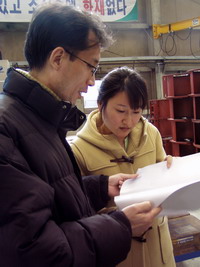
촬영장에서의 근엄한 표정과 카리스마 넘치는 말투. 우리가 텔레비젼에서 흔히 보고 꿈꾸던 프로듀서의 모습이다. 하지만 그 이전에 누구보다 바쁘게 촬영장 이 곳, 저 곳을 뛰어다니고 출연자와 스태프 하나, 하나를 살펴야 하는 것. 그것이 바로 우리가 알지 못했던 ‘진짜’ 프로듀서의 모습이다.
“막연하게만 생각했던 프로듀서라는 직업을 직접 보고 체험해 볼 수 있다는 점에서 의미있는 것 같아요.”
지난 24일, 평소 신문·방송 분야에 관심을 가지고 프로듀서를 꿈꾸는 신남정(정외2) 양과 함께 프로듀서 직업 일일체험을 위해 인천 남동공단의 한 공장 촬영장을 찾았다. 어려서부터 여러 스태프와 출연자들을 총괄하며 하나의 프로그램을 완성해 나가는 프로듀서의 생활에 큰 관심을 가지고 있던 만큼, 오늘의 일일체험이 크게 기대된다는 표정이다.
일일 체험을 위해 만난 EBS의 김철홍 프로듀서는 요즘 예비 취업인들을 대상으로 미리 직업을 체험하게 해주는 ‘직업체험’ 프로그램을 제작 중이다.
이번 주는 대학에서 기계 설비를 전공한 학생을 주인공으로, 한 중소기업에서 운영하는 생산 현장에서 촬영을 진행하게 됐다.
“바람이 차니깐 장소 이동하는 동안 스태프들과 출연자들은 차에서 몸 좀 녹이도록 합시다”
촬영계획표를 꼼꼼히 살피며 촬영장소와 소품 등을 정리하는 와중에도 출연자와 스태프들 챙기기에 여념이 없는 모습에서 김 PD의 세심함과 배려가 느껴진다. 프로듀서는 많은 스태프, 출연진들을 이끌어가야 하는 직업인만큼 사람을 상대하고 관리하는 것에 흥미를 느끼고 재능을 갖추어야 하는 것이 사실이다.
촬영장에는 총 책임자인 프로듀서 이외에도 촬영감독, 음향감독, 조명감독 등이 항상 함께한다. “촬영장에서는 항상 손에서 카메라를 놓지 않고 이곳 저곳의 구도를 살펴야 해요.” 촬영감독은 처음 보는 카메라를 신기한 듯 쳐다보는 신 양에게 카메라 기능 이것 저것을 설명해주며 렌즈를 직접 움직여 보게 한다.
“무엇보다도 현장에서의 경험이 중요해요. 이러한 직업의 꿈을 갖고 있다면 막연하게 생각하기보다는 이 분야와 관련한 아르바이트, 인턴십 등을 활용해 경험과 경력을 쌓는 것이 큰 도움이 될 수 있을거예요.” 김철홍 PD는 프로듀서를 꿈꾸는 많은 후배들에게 학점을 높게 받고, 영어 공부도 열심히 하는 것도 중요하지만 그 이전에 자신이 이 직업에 적합한 지를 알아보는 과정이 꼭 필요하다고 충고한다.
오늘의 체험을 통해 무엇보다도 프로듀서는 사람과의 관계를 중시해야 된다는 점을 배웠다는 신남정 양. 오늘의 경험이 그의 꿈에 한 발짝 다가설 수 있는 뜻 깊은 기회가 될 수 있기를 기대해본다.

